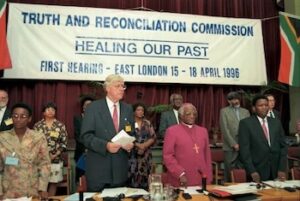
The Truth and Reconciliation Commission
*The Truth and Reconciliation Commission (TRC) was established on this date in 1996. The TRC was a court-like restorative justice body assembled in South Africa after the end of apartheid.
The TRC was set up in Cape Town under terms of the Promotion of National Unity and Reconciliation Act, No. 34 of 1995. The hearings started a year later. Authorized by Nelson Mandela and chaired by Desmond Tutu, the Commission invited witnesses identified as victims of gross human rights violations to give statements about their experiences and selected some for public hearings. Perpetrators of violence could also give testimony and request amnesty from both civil and criminal prosecution.
The Institute for Justice and Reconciliation was established in 2000 as the successor organization of the TRC. The Commission's mandate was to bear witness to, record, and, in some cases, grant amnesty to the perpetrators of crimes relating to human rights violations and offer reparation and rehabilitation to the victims. A reconciliation register established that ordinary South Africans who wished to regret past failures could also express their remorse.
Tutu enriched the TRC's mandate with the spirit of the indigenous African concept of Ubuntu, which translates across cultures as a spiritual awareness of our interconnectedness as a human family and, more specifically, in Xhosa, that we make one another human. The TRC's emphasis on reconciliation sharply contrasted with the approach taken by the Nuremberg trials and other de-Nazification measures. South Africa's first coalition government pursued forgiveness over prosecution and reparation over retaliation. On October 28, 1998, the Commission presented its report, which condemned both sides for committing atrocities.